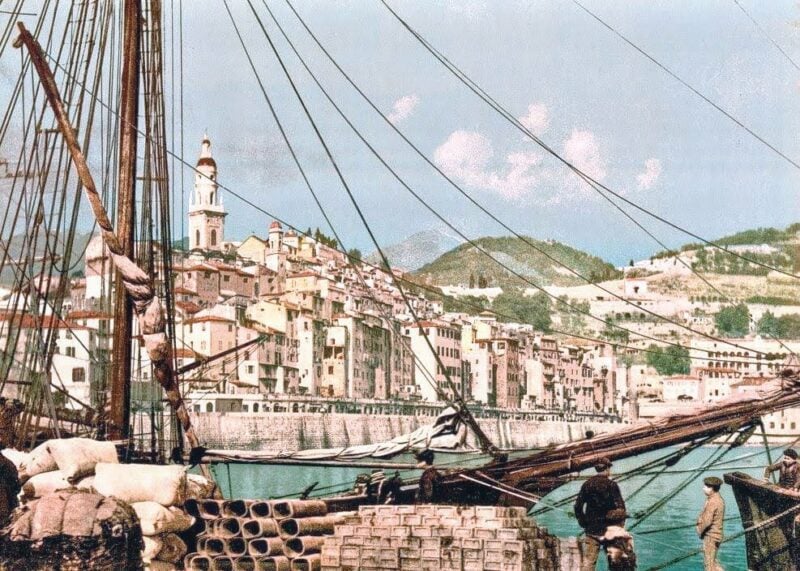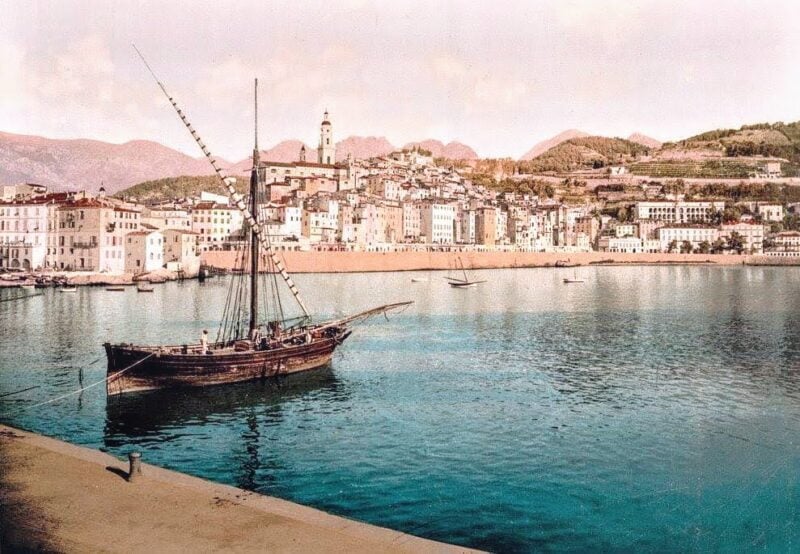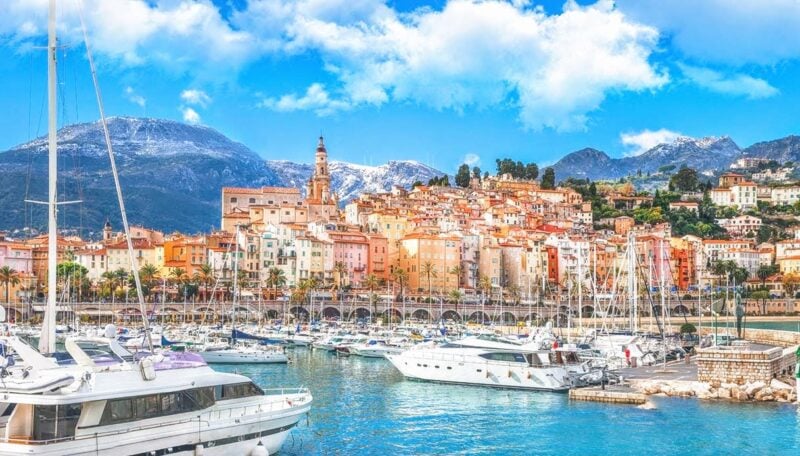Atalhos
O nascimento da 'Riviera Francesa'
The highly-Instagrammable seaside town of Menton pode ser menos conhecido do que seus vizinhos da Riviera, mas – junto com Nice – foi fundamental para estabelecer a Riviera Francesa como possivelmente o local de férias de inverno mais antigo do mundo. Jean Cocteau painted his famous frescoes of love here, and English nobles planted exotic gardens around Italianate villas shaded by palm trees.
Tribes and Romans
Traços de ocupação remontam a 3000 anos ou mais, mas até o final do século XVIII, a área mais tarde conhecida como Côte d'Azur era uma região remota e empobrecida, conhecida principalmente pela pesca, olivais e flores usadas em perfumes. Povos tribais agora chamados de “Ligurians” foram os primeiros habitantes conhecidos da Riviera Francesa em tempos históricos.
Pouco se sabe sobre esses aborígenes, apenas que eles construíram aldeias fortificadas, principalmente no local da moderna Nice. Alguns séculos depois, gregos de regiões superlotadas Phocaea moved, first into Massilia (Marselha), then outwards to Hyères and Nice, como costumavam fazer onde quer que houvesse oportunidade de indústria ou comércio.
The Greeks brought the vine (thoughtfully informing the earlier inhabitants what could be extracted from the wild stock indigenous to the area) as well as olives and other products of their advanced civilization. The Celts, who were at the same time putting down roots as far south as the Riviera, preferred the wilder hill country up from the coast — and to raid rather than trade.
The inhabitants of the land along this coastal strip had been accustomed to operating independently of “central” control. The Roman’s forced occupation –as commemorated by the trophy in La Turbie— foi uma exceção importante, mas mesmo assim o número de ocupantes era pequeno e eles tinham uma tarefa específica: defender o acesso romano e as rotas comerciais, com pouca preocupação com os habitantes locais.
Após a retirada romana, e antes do século XVIII, os bolsões de terra habitada eram minúsculos comparados às grandes faixas de encostas rochosas e arbustivas e estuários de rios pantanosos. As comunidades eram isoladas. Os mosquitos deixavam todo mundo louco, e se locomover era perigoso e lento (pouco mudou).
Above all, it was a dull place, poor and uncultured, dilapidated and neglected by the outside world. It was waiting to be “rescued”. Divided between French and “Italian” spheres of influence, it was not a coherent society even within its contentious borders. Then came the British to transform the area and create the “French Riviera” as we know it…
How the British Transformed the French Riviera
No século XVIII, um gosto por viagens se desenvolveu entre a aristocracia inglesa, especialmente passando o inverno na Riviera Francesa. Visto como um Jardim do Éden, o Sul da França também era a "rota" natural para a Itália e sua cultura, que era um lugar da moda para se vivenciar, entre as elites.

Essa migração sazonal das classes altas inglesas foi rapidamente copiada por outras elites europeias, todas em busca de um inverno ameno. No início do século XIX, surgiu o argumento da saúde – as pessoas iam a esses resorts de inverno como tratamento médico.
The 18th century created the winter resort, and the 19th century sealed it.
The first British traveller to describe the area’s health benefits was the novelist Tobias Smollett, que visitou Nice em 1763, quando ainda era uma cidade italiana dentro do Reino da Sardenha. Ele trouxe Nice e seu clima quente de inverno à atenção da aristocracia britânica com 'Travels through France and Italy (particularmente Nice)', escrito em 1766. É um diário de viagem muito divertido em forma de cartas, no qual ele se apaixonou por Nice, previu os méritos de Cannes (então uma pequena vila) como um resort de saúde e imaginou as possibilidades do Corniche roads. Soon after it was published, sickly Brits started traveling to the French Riviera, thereby establishing it as the first winter resort area in the world.
Almost immediately, Scottish doctor John Brown picked up on this idea and became famous for prescribing what he called ‘climato-therapy’: a change in climate, to cure a variety of diseases. In 1780, he published his ‘Elements of Medicine‘, which for a time was an influential text. It set out his theories, often called the ‘Brunonian system of medicine’, which essentially understood all diseases as a matter of over or under-stimulation. The controversial and simplistic so-called ‘Brunonian theory' ditou que todas as doenças se enquadram em uma de duas categorias: aquelas causadas pela ausência de estímulo e aquelas causadas por muito estímulo. Ele e seus contemporâneos consideravam o clima mediterrâneo como oferecendo uma variedade considerável de ambientes tônicos e sedativos.

Keeping the momentum going, British doctor John Bunnell Davis wrote his 1807 book, ‘A História Antiga e Moderna de Nice‘. It became yet another voice which advocated for the French Riviera’s curative effect on disease. He wrote, “Who can for a moment doubt but that health is more likely to return when the path to its acquisition is strewn with flowers; when the painful burden that overwhelms the soul is alleviated by agreeable occupations, and when anxiety is exchanged for patience and resignation?”
Essa teoria dominou o pensamento médico europeu por aproximadamente um século, até o final dos anos 1800, e toda a costa do Mediterrâneo se tornou uma espécie de resort de saúde de inverno para quem sofre de todos os tipos de doenças (especialmente tuberculose, que estava matando um em cada seis na Inglaterra). Depois que Napoleão foi derrotado em 1815 e a paz prevaleceu no continente, os britânicos em particular começaram a migrar para Nice, principalmente por sua saúde, e sempre no inverno.
François-Joseph-Victor Broussais, a famous French physician, became very popular in the beginning of the 1820s; his medicinal theory was based on the Brunonian theory. French historian Paul Gonnet noted that doctors sent “to our shores a colony of pale and listless English women and listless sons of nobility near death”.

The French Riviera’s popularity further exploded when British doctor James Henry Bennet started promoting Menton’s climate as a health cure-all. Bennet had studied medicine in Paris, and after working as a doctor for 25 years, contracted what he self-diagnosed as tuberculosis (isso foi antes de saberem que a causa era bactéria). Em 1859, ele alegou que foi a Menton para "...morrer em um canto tranquilo, como um habitante ferido da floresta" (mas é mais provável que ele estivesse familiarizado com a teoria brunoniana e tenha ido para ser curado). Mas, em vez disso, sua saúde melhorou muito, e ele visitou a Itália no ano seguinte, mas descobriu que o "estado anti-higiênico das grandes cidades daquela terra clássica desfez o bem obtido anteriormente". Não impressionado com a Itália, ele retornou a Menton e começou a exercer a medicina.
When he was completely healed he returned to England to let his patients know about Menton. Word spread fast, as notable patients of Bennet’s included Robert Louis Stevenson e Rainha Vitória. A partir de então, ele passou todos os invernos em Menton.
His 1861 book ‘Winter and Spring on the Shores of the Mediterranean‘ quickly boosted the popularity of Menton (then called ‘Mentone’) as a destination. Bennet felt that the hot and dry climate of the French Riviera as well as a proper diet cured tuberculosis sufferers. It was later translated into other languages and published in other countries, bringing everyone from Germans to Americans to Menton. Other doctors soon joined in the chorus.
Enquanto Lord Brougham had recently put Cannes on the map para membros cuidadosamente selecionados da alta sociedade de Londres, a leitura do livro de Bennet era ampla e criava um fluxo avassalador de turismo. Muitos aristocratas, a maioria com vários problemas de saúde, afluíam à Riviera Francesa com a esperança de serem curados. Sem dúvida, mais de uma vítima de "consumo" tinha asma em vez de tuberculose, e fugir das cidades britânicas frias, úmidas e muito poluídas teria sido toda a "cura" de que precisavam.

In 1882, Rainha Vitória seguiu o conselho de Bennet e veio para umas férias prolongadas, abrindo as comportas para a realeza e a alta sociedade seguirem. Ela visitou oito vezes depois disso e contou aos amigos o quanto amava a área.
At the Queen’s suggestion, Winston Churchill chose to paint its’ landscapes, and many famous 19th century travel writers (such as Robert Louis Stevenson, Somerset Maugham, Scott Fitzgerald, Ernest Hemingway, H.G. Wells, Edith Wharton, Louisa May Alcott and Aldous Huxley) started writing about it.
Railways were built, grand villas replaced stone farmhouses, and ornate carriages carrying dukes and princes started showing up along high coast roads above the sparkling sea. Soon after, the French Riviera became famous in the USA as a high-end and glamorous vacation spot for celebrities and jet-setters.
Throughout the 20th century, Americans further transformed the French Riviera, with many of the most famous American authors and movie stars spending time or moving here. Superstar Grace Kelly married the Prince of Monaco, Rita Hayworth met and married a prince here, Sean Connery comprou uma villa em Nice and filmed scenes of ‘Never Say Never’ in the old town of Menton, and Americans with wealth or fame vacationed here.
Without the influence of wealthy Brits and Americans, the French Riviera would not be what it is today.
The French finally discovered the area as a vacation spot well after the English-speakers, and eventually started building smaller vacation homes and apartment blocks up and down the coast. Now, the French Riviera is a crowded mix of tourists, English-speaking expats, and French people.